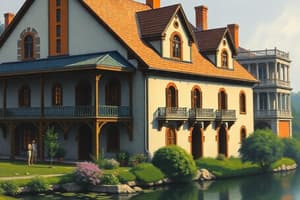Podcast
Questions and Answers
What is the primary function of a house?
What is the primary function of a house?
- To provide a sense of community
- To increase property value
- To provide shelter and comfort (correct)
- To display architectural style
Which type of house is attached to one or more houses via shared walls?
Which type of house is attached to one or more houses via shared walls?
- Mobile home
- Townhouse (correct)
- Semi-detached house
- Detached house
What is the purpose of the foundation of a house?
What is the purpose of the foundation of a house?
- To support the roof
- To transfer weight to the ground (correct)
- To install windows and doors
- To provide insulation
What is the primary purpose of a bedroom in a house?
What is the primary purpose of a bedroom in a house?
Which architectural style is characterized by clean lines and minimal ornamentation?
Which architectural style is characterized by clean lines and minimal ornamentation?
How can insulation and double glazing reduce energy consumption in a house?
How can insulation and double glazing reduce energy consumption in a house?
What is a benefit of using sustainable building materials in house construction?
What is a benefit of using sustainable building materials in house construction?
What is the purpose of low-flow fixtures and greywater reuse systems in a house?
What is the purpose of low-flow fixtures and greywater reuse systems in a house?
Flashcards are hidden until you start studying
Study Notes
Definition and Types
- A house is a building for human habitation, providing shelter and comfort.
- Types of houses:
- Detached house: a standalone house not attached to another house.
- Semi-detached house: two houses joined by a common wall.
- Townhouse: a multi-level house attached to one or more houses via shared walls.
- Apartment: a self-contained housing unit in a larger building.
- Mobile home: a prefabricated house designed to be transported.
Components and Features
- Basic components:
- Foundation: the base of the house, transferring weight to the ground.
- Walls: provide structural support and insulation.
- Roof: protects from weather and provides insulation.
- Windows and doors: allow natural light and ventilation.
- Features:
- Kitchen: a room for food preparation and cooking.
- Bathroom: a room for personal hygiene and sanitation.
- Bedroom: a room for sleeping and relaxation.
- Living room: a room for socializing and leisure.
Architectural Styles
- Popular architectural styles:
- Modern: characterized by clean lines, minimal ornamentation, and open spaces.
- Traditional: classic designs with ornate details and symmetrical facades.
- Victorian: ornate, intricate designs with multiple turrets and bay windows.
- Ranch: long, low-profile houses with a single story.
Sustainability and Environmental Impact
- Energy efficiency:
- Insulation and double glazing reduce heat loss and energy consumption.
- Renewable energy sources, such as solar panels, can power homes.
- Environmental impact:
- Building materials: sustainable options like recycled materials and low-VOC paints reduce waste and pollution.
- Water conservation: low-flow fixtures and greywater reuse systems minimize water waste.
Definition and Types of Houses
- A house is a building for human habitation, providing shelter and comfort.
- There are five main types of houses:
- Detached house: standalone, not attached to another house.
- Semi-detached house: two houses joined by a common wall.
- Townhouse: multi-level, attached to one or more houses via shared walls.
- Apartment: self-contained housing unit in a larger building.
- Mobile home: prefabricated, designed to be transported.
Components and Features of Houses
Basic Components
- Foundation: base of the house, transferring weight to the ground.
- Walls: provide structural support and insulation.
- Roof: protects from weather and provides insulation.
- Windows and doors: allow natural light and ventilation.
Features of Houses
- Kitchen: room for food preparation and cooking.
- Bathroom: room for personal hygiene and sanitation.
- Bedroom: room for sleeping and relaxation.
- Living room: room for socializing and leisure.
Architectural Styles
- Four popular architectural styles:
- Modern: clean lines, minimal ornamentation, and open spaces.
- Traditional: classic designs with ornate details and symmetrical facades.
- Victorian: ornate, intricate designs with multiple turrets and bay windows.
- Ranch: long, low-profile houses with a single story.
Sustainability and Environmental Impact of Houses
Energy Efficiency
- Insulation and double glazing reduce heat loss and energy consumption.
- Renewable energy sources, such as solar panels, can power homes.
Environmental Impact
- Sustainable building materials: recycled materials and low-VOC paints reduce waste and pollution.
- Water conservation: low-flow fixtures and greywater reuse systems minimize water waste.
Studying That Suits You
Use AI to generate personalized quizzes and flashcards to suit your learning preferences.




